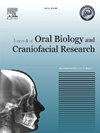评估简化混合法与传统数字法测量腭部容积的准确性
Q1 Medicine
Journal of oral biology and craniofacial research
Pub Date : 2024-11-26
DOI:10.1016/j.jobcr.2024.10.011
引用次数: 0
摘要
材料和方法从接受正畸治疗的患者记录中获取 30 个上颌骨铸模,并标记出预先设想的腭穹边界。样本被分为第一组(使用 CBCT 扫描估算体积)和第二组(使用混合方法估算体积)。在这项研究中,腭部容积的估算是用石膏(IV 型)石料填充腭部感兴趣的容积,并根据边界和解剖结构仔细雕刻。腭部空间的正面再现被安全提取出来,然后在 NewTom GiANO HR 锥形束成像装置中进行扫描。扫描结果通过 NNT 软件 3.10 版进行分析,并计算出腭部的体积。由两名经验丰富的正畸医生进行测量,以评估观察者之间和观察者内部的可靠性。结果这项研究显示,腭部体积的置信区间一致且范围较窄。因此,样本量充足且精确度高。考虑到 95% 的置信区间,混合法计算出的所有测量值的类内相关系数都很稳健(0.9),表明可靠性很高。腭部体积测量的平均差异(第一组与第二组)为 1.37 + 0.64 mm3,差异在统计学上不显著。在两种方法之间进行的统计 t 检验显示 p 值为 0.34,这意味着两种方法之间没有显著的统计学差异。这种简化方法的主要优点是患者不会受到 CBCT 的任何辐射。此外,数字化测量腭部容积不需要特定的技能。本文章由计算机程序翻译,如有差异,请以英文原文为准。

Evaluation of the accuracy of a simplified hybrid method versus the traditional digital method for measuring palatal volume
Objective
This study aimed to compare a direct conventional 3D digital technique vis a vis a hybrid method in measuring palatal volume.
Materials and methods
Thirty maxillary casts were obtained from the records of patients undergoing orthodontic treatment and pre-conceived boundaries of the palatal vault were marked. Sample was categorised into Group I (Volume estimation using CBCT scan) and Group II (Volume estimation using hybrid method). Estimation of the palatal volume in this study involved filling the volume of interest in the palate with gypsum (Type IV) stone material and carefully carving according to the boundaries and anatomy. This positive reproduction of the palatal space was safely retrieved and then scanned in the NewTom GiANO HR Cone Beam Imaging setup. The obtained scan was analysed in NNT Software Version 3.10 and the volume of the palate was calculated. Two experienced orthodontists carried out the measurements to evaluate the inter and intra-observer reliability. This was compared with the palatal volume calculated by the conventional digital method using CBCT in the NNT Software.
Result
This study showed a consistent and narrow range of the confidence interval for palatal volume. Hence, the sample size was sufficient and had good precision. Considering a 95 % confidence interval, the intra-class correlation coefficient was robust (>0.9) for all measurements calculated by the hybrid method suggesting a high reliability. The mean difference in measurement of palatal volume (Group I vs, Group II) was 1.37 + 0.64 mm3 and the difference was statistically insignificant. Statistical t-test conducted between the two methods showed a p-value of 0.34, implying no statistically significant difference between the two methods.
Conclusion
The hybrid method for evaluating the palatal volume is simple, accurate and comparable to the conventional digital method. A major advantage of this simplified method is that the patient is not exposed to any radiation of CBCT. Also, need for a specific skillset for digitally measuring the palatal volume is not a must.
求助全文
通过发布文献求助,成功后即可免费获取论文全文。
去求助
来源期刊

Journal of oral biology and craniofacial research
Medicine-Otorhinolaryngology
CiteScore
4.90
自引率
0.00%
发文量
133
审稿时长
167 days
期刊介绍:
Journal of Oral Biology and Craniofacial Research (JOBCR)is the official journal of the Craniofacial Research Foundation (CRF). The journal aims to provide a common platform for both clinical and translational research and to promote interdisciplinary sciences in craniofacial region. JOBCR publishes content that includes diseases, injuries and defects in the head, neck, face, jaws and the hard and soft tissues of the mouth and jaws and face region; diagnosis and medical management of diseases specific to the orofacial tissues and of oral manifestations of systemic diseases; studies on identifying populations at risk of oral disease or in need of specific care, and comparing regional, environmental, social, and access similarities and differences in dental care between populations; diseases of the mouth and related structures like salivary glands, temporomandibular joints, facial muscles and perioral skin; biomedical engineering, tissue engineering and stem cells. The journal publishes reviews, commentaries, peer-reviewed original research articles, short communication, and case reports.
 求助内容:
求助内容: 应助结果提醒方式:
应助结果提醒方式:


